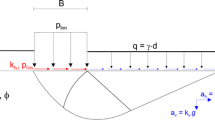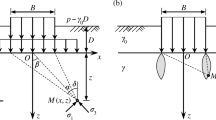Abstract
A rigorous solution aimed at accounting for the superposition and flow rule assumptions in the assessment of the bearing capacity of shallow strip footings under plane strain conditions has been developed using the method of characteristics and the finite element method. With reference to the Hill and Prandtl failure mechanisms, a bearing capacity factor Nγq and a superposition corrective coefficient μ that allow to directly obtain the actual bearing capacity of shallow strip foundations have been proposed. The geometry of the plastic volume involved in the failure mechanism has been also investigated, highlighting the influence of the superposition and flow rule assumptions. Starting from the numerical results obtained using the method of characteristics, several empirical relationships have been proposed for an accurate estimate of Nγq and μ as well as for the lateral extension and depth of the plastic volume. The accuracy of the numerical results has been checked through finite element analyses under the assumption of associated and non-associated flow rule showing that the proposed superposition corrective coefficient μ is not influenced by the flow rule assumption. Thus, a general bearing capacity equation for shallow strip footings has been provided which accounts for superposition approximation and non-associated flow rule.













Similar content being viewed by others
Data availability
The datasets generated during and/or analyzed during the current study are available from the corresponding author on reasonable request.
Abbreviations
- Δε s :
-
Incremental deviatoric strain
- γ :
-
Soil unit weight
- λ :
-
Surcharge ratio
- μ :
-
Superposition corrective coefficient
- σ′1, σ′3 :
-
Maximum and minimum principal effective stresses
- φ′:
-
Soil friction angle
- ψ :
-
Dilatancy angle
- ω :
-
Angle formed by the maximum principal effective stress with the horizontal axis
- B :
-
Foundation width
- C′:
-
Soil cohesion
- d :
-
Depth of the plastic volume
- N c, N q, N γ :
-
Bearing capacity factors
- N q N - A, N γ N - A :
-
Bearing capacity factors accounting for non-associated flow rule
- N γ q :
-
Generalized bearing capacity factor for the general case c′ ≠ 0, φ′ ≠ 0, q ≠ 0
- q :
-
Surface surcharge
- q ult :
-
Ultimate load according to the superposition assumption
- \(\overline{q}_{{{\text{ult}}}}\) :
-
Actual ultimate load
- s′:
-
Effective stress invariant
- S α, S β :
-
Curvilinear coordinates
- x :
-
Width of the plastic volume
References
Bolton MD, Lau CK (1993) Vertical bearing capacity factors for circular and strip footings on Mohr–Coulomb soil. Can Geotech J 30(6):1024–1033. https://doi.org/10.1139/t93-099
De Borst R, Vermeer PA (1984) Possibilities and limitations of finite elements for limit analysis. Géotechnique 34(2):199–210. https://doi.org/10.1680/geot.1984.34.2.199
Cascone E, Biondi G, Casablanca O (2019) Influence of earthquake-induced excess pore water pressures on seismic bearing capacity of shallow foundations. In: Earthquake geotechnical engineering for protection and development of environment and constructions. Proceedings of the 7th international conference on earthquake geotechnical engineering, pp 566–581
Cascone E, Biondi G, Casablanca O (2021) Groundwater effect on bearing capacity of shallow strip footings. Comput Geotech 139:104417. https://doi.org/10.1016/J.COMPGEO.2021.104417
Cox AD (1962) Axially-symmetric plastic deformation in soils—II. Indentation of ponderable soils. Int J Mech Sci 4(5):371–380. https://doi.org/10.1016/S0020-7403(62)80024-1
Davis EH, Booker JR (1971) The bearing capacity of strip footings from the standpoint of plasticity theory. In: Proceedings 1st Australia–New Zealand conference on geomechanics. Melbourne, Australia, pp 276–282
De Simone P (1985) Bearing capacity of a circular footing on a Coulomb medium. In: Proceedings of the 5th international conference on numerical methods in geomechanics, Nagoya, pp 829–836
Erickson HL, Drescher A (2002) Bearing capacity of circular footings. J Geotech Geoenviron Eng 128(1):38–43. https://doi.org/10.1061/(ASCE)1090-0241(2002)128:1(38)
Griffiths DV (1982) Computation of bearing capacity factors using finite elements. Géotechnique 32(3):195–202. https://doi.org/10.1680/geot.1982.32.3.195
Han DD (2021) An approximation solution to estimate the ultimate bearing capacity of smooth strip footings on ponderable soil. IOP Conf Ser Earth Environ Sci 787(1):012032. https://doi.org/10.1088/1755-1315/787/1/012032
Han D, Xie X, Zheng L, Huang L (2016) The bearing capacity factor Nγ of strip footings on c–ϕ–γ soil using the method of characteristics. Springerplus 5(1):1482. https://doi.org/10.1186/s40064-016-3084-6
Loukidis D, Chakraborty T, Salgado R (2008) Bearing capacity of strip footings on purely frictional soil under eccentric and inclined loads. Can Geotech J 45(6):768–787. https://doi.org/10.1139/T08-015
Loukidis D, Salgado R (2009) Bearing capacity of strip and circular footings in sand using finite elements. Comput Geotech 36(5):871–879. https://doi.org/10.1016/J.COMPGEO.2009.01.012
Manoharan N, Dasgupta SP (1995) Bearing capacity of surface footings by finite elements. Comput Struct 54(4):563–586. https://doi.org/10.1016/0045-7949(94)00381-C
Martin C (2005) Exact bearing capacity calculations using the method of characteristics. In: 11th International conference of the international association for computer methods and advances in geomechanics, pp 441–450
Nordal S (2008) Can we trust numerical collapse load simulations using non-associated flow rules?. In: Proceedings of the 12th international conference on IACMAG, pp 755–762
Nova R (2004) The role of non-normality in soil mechanics and some of its mathematical consequences. Comput Geotech 31(3):185–191. https://doi.org/10.1016/J.COMPGEO.2004.01.006
Plaxis 2D V21 (2021) Reference manual. Bentley Systems International Limited, Dublin, p 576
Prandtl L (1920) Über die Härte Plastischer Körper. Nachrichten der königlichen Gesellshaft der Wissenschaften Göttingen Mathematisch-Physikalische Klasse Languages, pp 74–85
Reissner H (1924) Zum Erddruckproblem. In: Proceedings of the 1st international conference applied mech. Delft, pp 295–311
Salençon J (1977) Applications of the theory of plasticity in soil mechanics. Wiley, Chichester, p 158
Sun JP, Zhao ZY, Cheng YP (2013) Bearing capacity analysis using the method of characteristics. Acta Mech Sin Xuebao 29:179–188. https://doi.org/10.1007/s10409-013-0018-1
Terzaghi K (1943) Theoretical soil mechanics. Wiley, New York. https://doi.org/10.1002/9780470172766
Vermeer PA (1990) The orientation of shear bands in biaxial tests. Géotechnique 40(2):223–236. https://doi.org/10.1680/geot.1990.40.2.223
Yin JH, Wang YJ, Selvadurai APS (2001) Influence of nonassociativity on the bearing capacity of a strip footing. J Geotech Geoenviron Eng 127(11):985–989. https://doi.org/10.1061/(ASCE)1090-0241(2001)127:11(985)
Zhu DY, Lee CF, Law KT (2003) Determination of bearing capacity of shallow foundations without using superposition approximation. Can Geotech J 40(2):450–459. https://doi.org/10.1139/t02-105
Acknowledgements
This work is part of the research activities carried out by the Messina Research Unit in the framework of the work package WP16—Contributi normativi—Geotecnica (Task 16.3) of a Research Project funded by the ReLuis (Network of Seismic Engineering University Laboratories) consortium (Accordo Quadro DPC/ReLUIS 2022-2024).
Author information
Authors and Affiliations
Corresponding author
Additional information
Publisher's Note
Springer Nature remains neutral with regard to jurisdictional claims in published maps and institutional affiliations.
Rights and permissions
Springer Nature or its licensor (e.g. a society or other partner) holds exclusive rights to this article under a publishing agreement with the author(s) or other rightsholder(s); author self-archiving of the accepted manuscript version of this article is solely governed by the terms of such publishing agreement and applicable law.
About this article
Cite this article
Casablanca, O., Cascone, E. & Biondi, G. Influence of the superposition and flow rule assumptions on the bearing capacity of shallow strip footings. Acta Geotech. (2024). https://doi.org/10.1007/s11440-024-02284-1
Received:
Accepted:
Published:
DOI: https://doi.org/10.1007/s11440-024-02284-1




